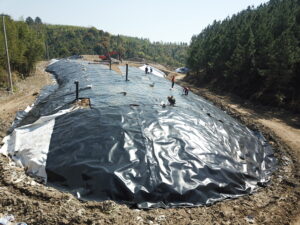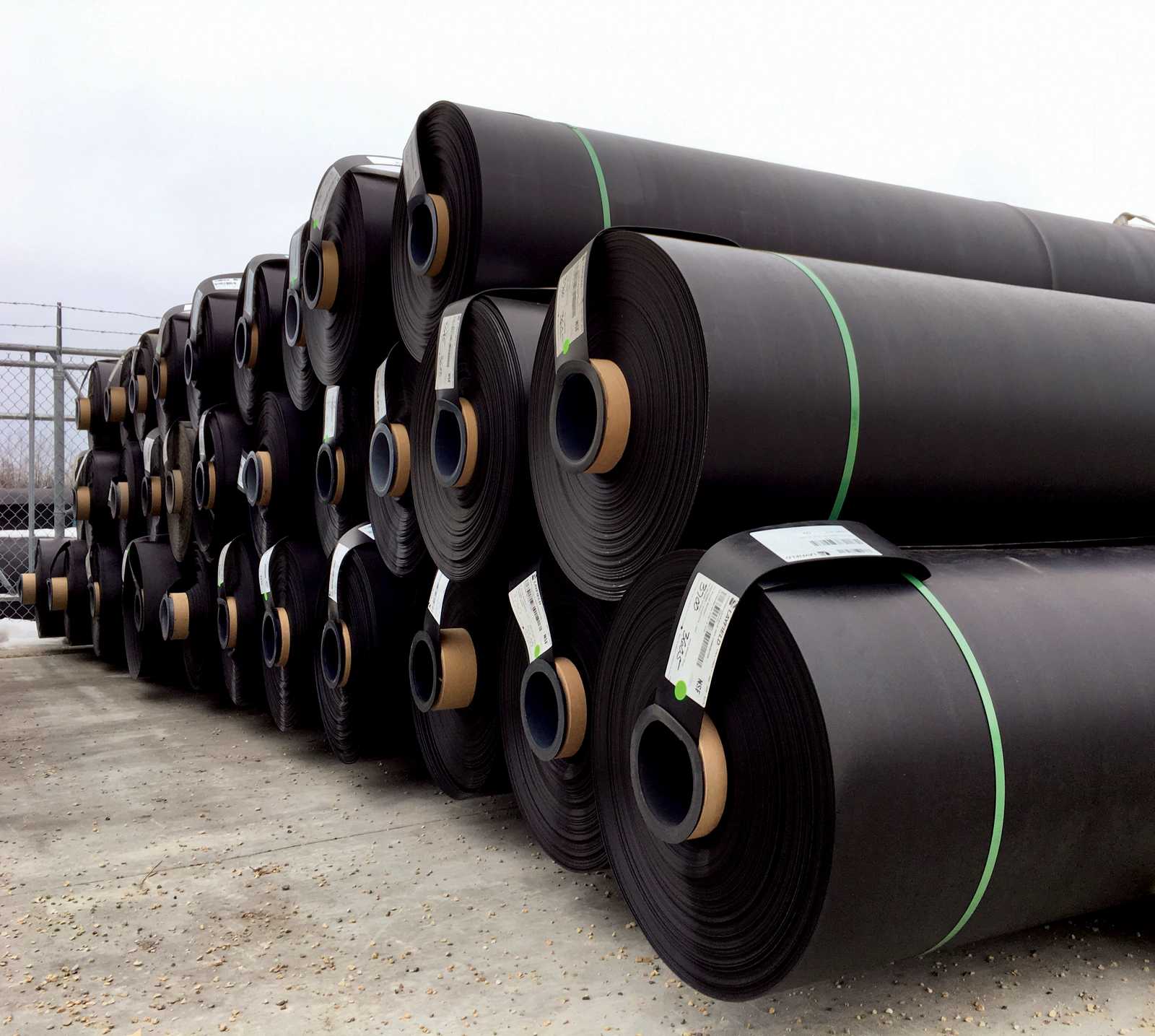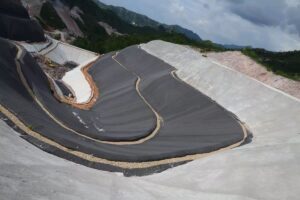What is a geomembrane lining?
Geomembrane lining generally refers to the practice of using geomembranes to cover or line a variety of engineering projects to prevent moisture penetration or protect underground structures. This technique is very common in civil engineering, environmental engineering and water resources management and has a variety of important applications.
Here are some of the main uses of geomembrane liners:
Waterproofing: Geomembrane liners are used to create a waterproofing layer to stop moisture from penetrating into buildings, pools, sewage treatment basins, underground tanks, tunnels and other structures. This helps protect infrastructure and prevent water damage.
Waste Management: In landfills and hazardous waste storage sites, geomembrane liners are used to prevent waste from seeping into groundwater. This helps reduce the risk of environmental pollution.
Levees and Dams: Geomembrane liners can be used as impermeable layers in levees and dams to reduce water infiltration and maintain reservoir stability.
Infiltration Control: Geomembrane liners can be used to control groundwater flow to maintain soil stability and prevent erosion.
Water Management: In reservoirs, irrigation channels, ponds and water management projects, geomembrane liners can be used to store water and control leakage.
Underground Storage Tanks: Underneath petroleum, chemical or other liquid storage tanks, geomembrane liners are used to prevent leaks and groundwater contamination.
Agricultural Irrigation: Geomembrane liners can be used in irrigation systems to reduce water loss and maintain soil moisture.
Geomembrane liners are typically made from materials such as high-density polyethylene (HDPE) or low-density polyethylene (LDPE), which offer excellent impermeability and durability.
Selecting the appropriate geomembrane type and size depends on the needs and environmental requirements of the specific project.
Be sure to follow applicable building and environmental regulations when using geomembrane liners to ensure safety and compliance.
Specifications of geomembrane
Geomembrane specifications can vary based on specific engineering needs and project requirements. Geomembranes are typically made from materials such as high-density polyethylene (HDPE), low-density polyethylene (LDPE) or polypropylene (PP), and the specifications of these materials can vary depending on the manufacturer and application. The following are some common geomembrane specifications and parameters:
Thickness: The thickness of geomembrane is usually measured in millimeters (mm). Common thicknesses include 0.5mm, 1mm, 1.5mm, 2mm, etc. Thickness selection is usually based on required impermeability and engineering requirements.
Width: Geomembranes are usually supplied in roll form, and the width can be determined according to project requirements, usually between 3 meters and 7 meters. Larger or smaller widths can also be produced as required for specific projects.
Length: Geomembrane roll length usually depends on the manufacturer and project needs. Standard roll lengths are usually between 50m and 100m but can also be supplied in custom lengths.
Color: Geomembranes are typically black or white, but other colors can be customized based on project needs. Black geomembranes are typically used as a waterproof layer beneath the soil, while white geomembranes may be used to reflect sunlight to reduce temperatures.
Tear strength: The tear strength of geomembranes is usually measured in Newtons per millimeter (N/mm) or kilograms of force per centimeter (kgf/cm). This is an important parameter in evaluating the strength and durability of geomembranes.
Puncture resistance: The puncture resistance of a geomembrane represents its ability to resist puncture by sharp objects, usually measured in Newtons (N) or kilograms of force (kgf).
Anti-aging properties: Geomembranes usually need to have good UV and chemical aging resistance to ensure their long-term stability.
Permeability: The impermeability of a geomembrane is a key parameter, usually measured as the impermeability coefficient (usually measured in meters per second), used to determine its performance in preventing moisture penetration.
These specifications and parameters will vary depending on the needs of the specific project. When selecting a geomembrane, these parameters typically need to be considered with the manufacturer and engineer to ensure that the appropriate specifications are selected to meet the requirements of the project.

What are the advantages of geomembrane tanks?
Geomembrane tanks, generally referring to containers used to store various liquids or wastes, are usually made of plastic and coated with a geomembrane to provide additional protection against penetration. This type of storage tank offers several advantages in many industrial and environmental applications, including:
Anti-permeability: Geomembrane tanks have excellent anti-permeability, which can effectively prevent storage liquids or waste from penetrating into the ground or soil, thereby reducing the risk of environmental pollution.
Environmentally Friendly: Geomembrane tanks help reduce environmental impact and soil contamination by preventing chemical waste, hazardous materials or liquid fertilizers from seeping into the soil and groundwater.
Durability: Geomembrane tanks are made of durable plastic that resists chemical corrosion and physical breakage, giving them a long life.
Adjustable capacity: The capacity of the geomembrane tank can be customized as needed to meet the storage needs of different projects.
Ease of installation: Geomembrane tanks are generally easier to install and maintain than some other tank types. They can be constructed quickly, reducing construction time.
Low cost: Geomembrane tanks generally have relatively low manufacturing and installation costs, especially compared to traditional concrete storage tanks.
Mobility: Some geomembrane tanks are designed to be removable and can be relocated as needed. This flexibility is useful for some temporary projects or short-term storage needs.
Multiple Applications: Geomembrane tanks can be used not only for liquid waste storage but also for various applications such as water resources management, irrigation reservoirs, liquid fertilizer storage, storm water collection, etc.
Although geomembrane tanks have significant advantages in terms of anti-permeability, environmental regulations and storage requirements still need to be followed when selecting and using them to ensure safety and environmental protection.
Author
-

Founded in 2002, Tinhy's team focuses on the manufacturing, marketing, installation, application and research and development of geosynthetic materials.
View all posts





